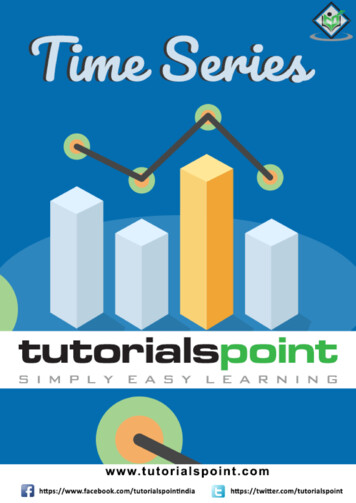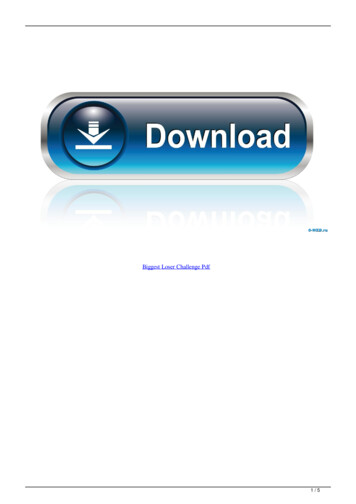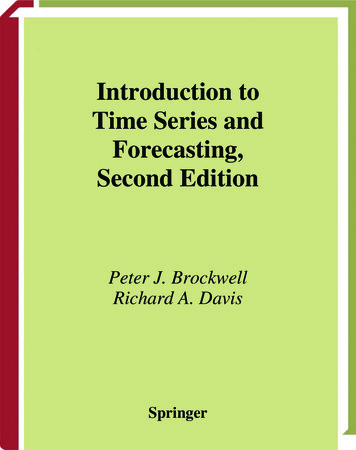
Transcription
Time SeriesAbout the TutorialA time series is a sequence of observations over a certain period. The simplest exampleof a time series that all of us come across on a day to day basis is the change intemperature throughout the day or week or month or year.The analysis of temporal data is capable of giving us useful insights on how a variablechanges over time.This tutorial will teach you how to analyze and forecast time series data with the help ofvarious statistical and machine learning models in elaborate and easy to understand way!AudienceThis tutorial is for the inquisitive minds who are looking to understand time series andtime series forecasting models from scratch. At the end of this tutorial you will have agood understanding on time series modelling.PrerequisitesThis tutorial only assumes a preliminary understanding of Python language. Although thistutorial is self-contained, it will be useful if you have understanding of statisticalmathematics.If you are new to either Python or Statistics, we suggest you to pick up a tutorial basedon these subjects first before you embark on your journey with Time Series.Copyright & Disclaimer Copyright 2019 by Tutorials Point (I) Pvt. Ltd.All the content and graphics published in this e-book are the property of Tutorials Point (I)Pvt. Ltd. The user of this e-book is prohibited to reuse, retain, copy, distribute or republishany contents or a part of contents of this e-book in any manner without written consentof the publisher.We strive to update the contents of our website and tutorials as timely and as precisely aspossible, however, the contents may contain inaccuracies or errors. Tutorials Point (I) Pvt.Ltd. provides no guarantee regarding the accuracy, timeliness or completeness of ourwebsite or its contents including this tutorial. If you discover any errors on our website orin this tutorial, please notify us at contact@tutorialspoint.comi
Time SeriesTable of ContentsAbout the Tutorial . iAudience . iPrerequisites . iCopyright & Disclaimer. iTable of Contents . ii1.TIME SERIES – INTRODUCTION . 12.TIME SERIES – PROGRAMMING LANGUAGES . 23.TIME SERIES – PYTHON LIBRARIES . 34.TIME SERIES – DATA PROCESSING AND VISUALIZATION . 55.TIME SERIES – MODELING . 10Introduction . 10Time Series Modeling Techniques . 106.TIME SERIES – PARAMETER CALIBRATION . 12Introduction . 12Methods for Calibration of Parameters . 127.TIME SERIES – NAÏVE METHODS . 13Introduction . 138.TIME SERIES – AUTO REGRESSION . 159.TIME SERIES – MOVING AVERAGE . 1710.TIME SERIES - ARIMA . 1911.TIME SERIES – VARIATIONS OF ARIMA . 2212.TIME SERIES – EXPONENTIAL SMOOTHING . 27ii
Time SeriesSimple Exponential Smoothing . 27Triple Exponential Smoothing . 2713.TIME SERIES – WALK FORWARD VALIDATION . 2914.TIME SERIES – PROPHET MODEL . 3115.TIME SERIES – LSTM MODEL . 3216.TIME SERIES – ERROR METRICS. 3817.TIME SERIES – APPLICATIONS. 4018.TIME SERIES – FURTHER SCOPE . 41iii
1. Time Series – IntroductionTime SeriesA time series is a sequence of observations over a certain period. A univariate time seriesconsists of the values taken by a single variable at periodic time instances over a period,and a multivariate time series consists of the values taken by multiple variables at thesame periodic time instances over a period. The simplest example of a time series that allof us come across on a day to day basis is the change in temperature throughout the dayor week or month or year.The analysis of temporal data is capable of giving us useful insights on how a variablechanges over time, or how it depends on the change in the values of other variable(s).This relationship of a variable on its previous values and/or other variables can be analyzedfor time series forecasting and has numerous applications in artificial intelligence.1
2. Time Series – Programming LanguagesTime SeriesA basic understanding of any programming language is essential for a user to work withor develop machine learning problems. A list of preferred programming languages foranyone who wants to work on machine learning is given below:PythonIt is a high-level interpreted programming language, fast and easy to code. Python canfollow either procedural or object-oriented programming paradigms. The presence of avariety of libraries makes implementation of complicated procedures simpler. In thistutorial, we will be coding in Python and the corresponding libraries useful for time seriesmodelling will be discussed in the upcoming chapters.RSimilar to Python, R is an interpreted multi-paradigm language, which supports statisticalcomputing and graphics. The variety of packages makes it easier to implement machinelearning modelling in R.JavaIt is an interpreted object-oriented programming language, which is widely famous for alarge range of package availability and sophisticated data visualization techniques.C/C These are compiled languages, and two of the oldest programming languages. Theselanguages are often preferred to incorporate ML capabilities in the already existingapplications as they allow you to customize the implementation of ML algorithms easily.MATLABMATrix LABoratory is a multi-paradigm language which gives functioning to work withmatrices. It allows mathematical operations for complex problems. It is primarily used fornumerical operations but some packages also allow the graphical multi-domain simulationand model-based design.Other preferred programming languages for machine learning problems include Javascript,LISP, Prolog, SQL, Scala, Julia, SAS etc.2
3. Time Series – Python LibrariesTime SeriesPython has an established popularity among individuals who perform machine learningbecause of its easy-to-write and easy-to-understand code structure as well as a widevariety of open source libraries. A few of such open source libraries that we will be usingin the coming chapters have been introduced below.NumPyNumerical Python is a library used for scientific computing. It works on an N-dimensionalarray object and provides basic mathematical functionality such as size, shape, mean,standard deviation, minimum, maximum as well as some more complex functions such aslinear algebraic functions and Fourier transform. You will learn more about these as wemove ahead in this tutorial.PandasThis library provides highly efficient and easy-to-use data structures such as series,dataframes and panels. It has enhanced Python’s functionality from mere data collectionand preparation to data analysis. The two libraries, Pandas and NumPy, make anyoperation on small to very large dataset very simple. To know more about these functions,follow this tutorial.SciPyScience Python is a library used for scientific and technical computing. It providesfunctionalities for optimization, signal and image processing, integration, interpolation andlinear algebra. This library comes handy while performing machine learning. We willdiscuss these functionalities as we move ahead in this tutorial.Scikit LearnThis library is a SciPy Toolkit widely used for statistical modelling, machine learning anddeep learning, as it contains various customizable regression, classification and clusteringmodels. It works well with Numpy, Pandas and other libraries which makes it easier touse.StatsmodelsLike Scikit Learn, this library is used for statistical data exploration and statisticalmodelling. It also operates well with other Python libraries.MatplotlibThis library is used for data visualization in various formats such as line plot, bar graph,heat maps, scatter plots, histogram etc. It contains all the graph related functionalitiesrequired from plotting to labelling. We will discuss these functionalities as we move aheadin this tutorial.These libraries are very essential to start with machine learning with any sort of data.3
Time SeriesBeside the ones discussed above, another library especially significant to deal with timeseries is:DatetimeThis library, with its two modules – datetime and calendar, provides all necessary datetimefunctionality for reading, formatting and manipulating time.We shall be using these libraries in the coming chapters.4
4. Time Series – Data Processing and VisualizationTime SeriesTime Series is a sequence of observations indexed in equi-spaced time intervals. Hence,the order and continuity should be maintained in any time series.The dataset we will be using is a multi-variate time series having hourly data forapproximately one year, for air quality in a significantly polluted Italian city. The datasetcan be downloaded from the link given below:http://archive.ics.uci.edu/ml/datasets/air qualityIt is necessary to make sure that: The time series is equally spaced, and There are no redundant values or gaps in it.In case the time series is not continuous, we can upsample or downsample it.Showing df.head()In [122]:import pandasIn [123]:df pandas.read csv("AirQualityUCI.csv", sep ";", decimal ",")df df.iloc[ : , 0:14]In [124]:len(df)Out[124]:9471In [125]:df.head()Out[125]:5
Time SeriesFor preprocessing the time series, we make sure there are no NaN(NULL) values in thedataset; if there are, we can replace them with either 0 or average or preceding orsucceeding values. Replacing is a preferred choice over dropping so that the continuity ofthe time series is maintained. However, in our dataset the last few values seem to be NULLand hence dropping will not affect the continuity.Dropping NaN(Not-a-Number)In 2)114PT08.S5(O3)114T114RH114dtype: int64In [127]:df df[df['Date'].notnull()]In 8.S1(CO)0NMHC(GT)06
Time NO2(GT)0PT08.S4(NO2)0PT08.S5(O3)0T0RH0dtype: int64Time Series are usually plotted as line graphs against time. For that we will now combinethe date and time column and convert it into a datetime object from strings. This can beaccomplished using the datetime library.Converting to datetime objectIn [129]:df['DateTime'] (df.Date) ' ' (df.Time)print (type(df.DateTime[0])) class 'str' In [130]:import datetimedf.DateTime df.DateTime.apply(lambda x: datetime.datetime.strptime(x,'%d/%m/%Y %H.%M.%S'))print (type(df.DateTime[0])) class 'pandas. libs.tslibs.timestamps.Timestamp' Let us see how some variables like temperature changes with change in time.Showing plotsIn [131]:df.index df.DateTimeIn [132]:import matplotlib.pyplot as pltplt.plot(df['T'])7
Time SeriesOut[132]:[ matplotlib.lines.Line2D at 0x1eaad67f780 ]In [208]:plt.plot(df['C6H6(GT)'])Out[208]:[ matplotlib.lines.Line2D at 0x1eaaeedff28 ]Box-plots are another useful kind of graphs that allow you to condense a lot of informationabout a dataset into a single graph. It shows the mean, 25% and 75% quartile and outliersof one or multiple variables. In the case when number of outliers is few and is very distantfrom the mean, we can eliminate the outliers by setting them to mean value or 75%quartile value.Showing BoxplotsIn 134]:{'whiskers': [ matplotlib.lines.Line2D at 0x1eaac16de80 , matplotlib.lines.Line2D at 0x1eaac16d908 , matplotlib.lines.Line2D at 0x1eaac177a58 , matplotlib.lines.Line2D at 0x1eaac177cf8 ],'caps': [ matplotlib.lines.Line2D at 0x1eaac16d2b0 , matplotlib.lines.Line2D at 0x1eaac16d588 , matplotlib.lines.Line2D at 0x1eaac1a69e8 , matplotlib.lines.Line2D at 0x1eaac1a64a8 ],8
Time Series'boxes': [ matplotlib.lines.Line2D at 0x1eaac16dc50 , matplotlib.lines.Line2D at 0x1eaac1779b0 ],'medians': [ matplotlib.lines.Line2D at 0x1eaac16d4a8 , matplotlib.lines.Line2D at 0x1eaac1a6c50 ],'fliers': [ matplotlib.lines.Line2D at 0x1eaac177dd8 , matplotlib.lines.Line2D at 0x1eaac1a6c18 ],'means': []}9
5. Time Series – ModelingTime SeriesIntroductionA time series has 4 components as given below: Level: It is the mean value around which the series varies. Trend: It is the increasing or decreasing behavior of a variable with time. Seasonality: It is the cyclic behavior of time series. Noise: It is the error in the observations added due to environmental factors.Time Series Modeling TechniquesTo capture these components, there are a number of popular time series modellingtechniques. This section gives a brief introduction of each technique, however we willdiscuss about them in detail in the upcoming chapters:Naïve MethodsThese are simple estimation techniques, such as the predicted value is given the valueequal to mean of preceding values of the time dependent variable, or previous actualvalue. These are used for comparison with sophisticated modelling techniques.Auto RegressionAuto regression predicts the values of future time periods as a function of values atprevious time periods. Predictions of auto regression may fit the data better than that ofnaïve methods, but it may not be able to account for seasonality.ARIMA ModelAn auto-regressive integrated moving-average models the value of a variable as a linearfunction of previous values and residual errors at previous time steps of a stationary timeseries. However, the real world data may be non-stationary and have seasonality, thusSeasonal-ARIMA and Fractional-ARIMA were developed. ARIMA works on univariate timeseries, to handle multiple variables VARIMA was introduced.Exponential SmoothingIt models the value of a variable as an exponential weighted linear function of previousvalues. This statistical model can handle trend and seasonality as well.LSTMLong Short-Term Memory model (LSTM) is a recurrent neural network which is used fortime series to account for long term dependencies. It can be trained with large amount ofdata to capture the trends in multi-variate time series.10
Time SeriesThe said modelling techniques are used for time series regression. In the coming chapters,let us now explore all these one by one.11
6. Time Series – Parameter CalibrationTime SeriesIntroductionAny statistical or machine learning model has some parameters which greatly influencehow the data is modeled. For example, ARIMA has p, d, q values. These parameters areto be decided such that the error between actual values and modeled values is minimum.Parameter calibration is said to be the most crucial and time-consuming task of modelfitting. Hence, it is very essential for us to choose optimal parameters.Methods for Calibration of ParametersThere are various ways to calibrate parameters. This section talks about some of them indetail.Hit-and-tryOne common way of calibrating models is hand calibration, where you start by visualizingthe time-series and intuitively try some parameter values and change them over and overuntil you achieve a good enough fit. It requires a good understanding of the model we aretrying. For ARIMA model, hand calibration is done with the help of auto-correlation plot for‘p’ parameter, partial auto-correlation plot for ‘q’ parameter and ADF-test to confirm thestationarity of time-series and setting ‘d’ parameter. We will discuss all these in detail inthe coming chapters.Grid SearchAnother way of calibrating models is by grid search, which essentially means you trybuilding a model for all possible combinations of parameters and select the one withminimum error. This is time-consuming and hence is useful when number of parametersto be calibrated and range of values they take are fewer as this involves multiple nestedfor loops.Genetic AlgorithmGenetic algorithm works on the biological principle that a good solution will eventuallyevolve to the most ‘optimal’ solution. It uses biological operations of mutation, cross-overand selection to finally reach to an optimal solution.For further knowledge you can read about other parameter optimization techniques likeBayesian optimization and Swarm optimization.12
7. Time Series – Naïve MethodsTime SeriesIntroductionNaïve Methods such as assuming the predicted value at time ‘t’ to be the actual value ofthe variable at time ‘t-1’ or rolling mean of series, are used to weigh how well do thestatistical models and machine learning models can perform and emphasize their need.In this chapter, let us try these models on one of the features of our time-series data.First we shall see the mean of the ‘temperature’ feature of our data and the deviationaround it. It is also useful to see maximum and minimum temperature values. We can usethe functionalities of numpy library here.Showing statisticsIn [135]:import numpyprint ('Mean: ',numpy.mean(df['T']), '; Standard Deviation:',numpy.std(df['T']),'; \nMaximum Temperature: ',max(df['T']),'; MinimumTemperature: ',min(df['T']))We have the statistics for all 9357 observations across equi-spaced timeline which areuseful for us to understand the data.Now we will try the first naïve method, setting the predicted value at present time equalto actual value at previous time and calculate the root mean squared error(RMSE) for it toquantify the performance of this method.Showing 1st naïve methodIn [136]:df['T']df['T t-1'] df['T'].shift(1)In [137]:df naive df[['T','T t-1']][1:]In [138]:from sklearn import metricsfrom math import sqrttrue df naive['T']13
Time Seriesprediction df naive['T t-1']error sqrt(metrics.mean squared error(true,prediction))print ('RMSE for Naive Method 1: ', error)RMSE for Naive Method 1: 12.901140576492974Let us see the next naïve method, where predicted value at present time is equated to themean of the time periods preceding it. We will calculate the RMSE for this method too.Showing 2nd naïve methodIn [139]:df['T rm'] df['T'].rolling(3).mean().shift(1)df naive df[['T','T rm']].dropna()In [140]:true df naive['T']prediction df naive['T rm']error sqrt(metrics.mean squared error(true,prediction))print ('RMSE for Naive Method 2: ', error)RMSE for Naive Method 2: 14.957633272839242Here, you can experiment with various number of previous time periods also called ‘lags’you want to consider, which is kept as 3 here. In this data it can be seen that as youincrease the number of lags and error increases. If lag is kept 1, it becomes same as thenaïve method used earlier.Points to Note You can write a very simple function for calculating root mean squared error. Here,we have used the mean squared error function from the package ‘sklearn’ and thentaken its square root. In pandas df[‘column name’] can also be written as df.column name, however forthis dataset df.T will not work the same as df[‘T’] because df.T is the function fortransposing a dataframe. So use only df[‘T’] or consider renaming this columnbefore using the other syntax.14
8. Time Series – Auto RegressionTime SeriesFor a stationary time series, an auto regression models sees the value of a variable at time‘t’ as a linear function of values ‘p’ time steps preceding it. Mathematically it can be writtenas:Where,‘p’ is the auto-regressive trend parameter𝜖𝑡is white noise, and𝑦𝑡 1 , 𝑦𝑡 2 𝑦𝑡 𝑝 denote the value of variable at previous timeperiods.The value of p can be calibrated using various methods. One way of finding the apt valueof ‘p’ is plotting the auto-correlation plot.Note: We should separate the data into train and test at 8:2 ratio of total data availableprior to doing any analysis on the data because test data is only to find out the accuracyof our model and assumption is, it is not available to us until after predictions have beenmade. In case of time series, sequence of data points is very essential so one should keepin mind not to lose the order during splitting of data.An auto-correlation plot or a correlogram shows the relation of a variable with itself atprior time steps. It makes use of Pearson’s correlation and shows the correlations within95% confidence interval. Let’s see how it looks like for ‘temperature’ variable of our data.Showing ACPIn [141]:split len(df) - int(0.2*len(df))train, test df['T'][0:split], df['T'][split:]In [142]:from statsmodels.graphics.tsaplots import plot acfplot acf(train, lags 100)plt.show()15
Time SeriesAll the lag values lying outside the shaded blue region are assumed to have a correlation.16
9. Time Series – Moving AverageTime SeriesFor a stationary time series, a moving average model sees the value of a variable at time‘t’ as a linear function of residual errors from ‘q’ time steps preceding it. The residual erroris calculated by comparing the value at the time ‘t’ to moving average of the valuespreceding.Mathematically it can be written as:Where‘q’ is the moving-average trend parameter𝜖𝑡is white noise, and𝜖𝑡 1 , 𝜖𝑡 2 𝜖𝑡 𝑞 are the error terms at previous time periods.Value of ‘q’ can be calibrated using various methods. One way of finding the apt value of‘q’ is plotting the partial auto-correlation plot.A partial auto-correlation plot shows the relation of a variable with itself at prior time stepswith indirect correlations removed, unlike auto-correlation plot which shows direct as wellas indirect correlations, let’s see how it looks like for ‘temperature’ variable of our data.Showing PACPIn [143]:from statsmodels.graphics.tsaplots import plot pacfplot pacf(train, lags 100)plt.show()17
Time SeriesA partial auto-correlation is read in the same way as a correlogram.18
10. Time Series - ARIMATime SeriesWe have already understood that for a stationary time series a variable at time ‘t’ is alinear function of prior observations or residual errors. Hence it is time for us to combinethe two and have an Auto-regressive moving average (ARMA) model.However, at times the time series is not stationary, i.e the statistical properties of a serieslike mean, variance changes over time. And the statistical models we have studied so farassume the time series to be stationary, therefore, we can include a pre-processing stepof differencing the time series to make it stationary. Now, it is important for us to find outwhether the time series we are dealing with is stationary or not.Various methods to find the stationarity of a time series are looking for seasonality ortrend in the plot of time series, checking the difference in mean and variance for varioustime periods, Augmented Dickey-Fuller (ADF) test, KPSS test, Hurst’s exponent etc.Let us see whether the ‘temperature’ variable of our dataset is a stationary time series ornot using ADF test.In [74]:from statsmodels.tsa.stattools import adfullerresult adfuller(train)print('ADF Statistic: %f' % result[0])print('p-value: %f' % result[1])print('Critical Values:')for key, value In result[4].items()print('\t%s: %.3f' % (key, value))ADF Statistic: -10.406056p-value: 0.000000Critical Values:1%: -3.4315%: -2.86210%: -2.567Now that we have run the ADF test, let us interpret the result. First we will compare theADF Statistic with the critical values, a lower critical value tells us the series is most likelynon-stationary. Next, we see the p-value. A p-value greater than 0.05 also suggests thatthe time series is non-stationary.Alternatively, p-value less than or equal to 0.05, or ADF Statistic less than critical valuessuggest the time series is stationary.19
Time SeriesHence, the time series we are dealing with is already stationary. In case of stationary timeseries, we set the ‘d’ parameter as 0.We can also confirm the stationarity of time series using Hurst exponent.In [75]:import hurstH, c,data hurst.compute Hc(train)print("H {:.4f}, c {:.4f}".format(H,c))H 0.1660, c 5.0740The value of H 0.5 shows anti-persistent behavior, and H 0.5 shows persistent behavioror a trending series. H 0.5 shows random walk/Brownian motion. The value of H 0.5,confirming that our series is stationary.For non-stationary time series, we set ‘d’ parameter as 1. Also, the value of the autoregressive trend parameter ‘p’ and the moving average trend parameter ‘q’, is calculatedon the stationary time series i.e by plotting ACP and PACP after differencing the timeseries.ARIMA Model, which is characterized by 3 parameter, (p,d,q) are now clear to us, so letus model our time series and predict the future values of temperature.In [156]:from statsmodels.tsa.arima model import ARIMAmodel ARIMA(train.values, order (5, 0, 2))model fit model.fit(disp False)In [157]:predictions model fit.predict(len(test))test pandas.DataFrame(test)test ['predictions'] predictions[0:1871]In [158]:plt.plot(df['T'])plt.plot(test .predictions)plt.show()20
Time SeriesIn [167]:error sqrt(metrics.mean squared error(test.values,predictions[0:1871]))print ('Test RMSE for ARIMA: ', error)Test RMSE for ARIMA: 43.2125294023489221
11. Time Series – Variations of ARIMATime SeriesIn the previous chapter, we have now seen how ARIMA model works, and its limitationsthat it cannot handle seasonal data or multivariate time series and hence, new modelswere introduced to include these features.A glimpse of these new models is given here:Vector Auto-Regression (VAR)It is a generalized version of auto regression model for multivariate stationary time series.It is characterized by ‘p’ parameter.Vector Moving Average (VMA)It is a generalized version of moving average model for multivariate stationary time series.It is characterized by ‘q’ parameter.Vector Auto Regression Moving Average (VARMA)It is the combination of VAR and VMA and a generalized version of ARMA model formultivariate stationary time series. It is characterized by ‘p’ and ‘q’ parameters. Much like,ARMA is capable of acting like an AR model by setting ‘q’ parameter as 0 and as a MAmodel by setting ‘p’ parameter as 0, VARMA is also capable of acting like an VAR modelby setting ‘q’ parameter as 0 and as a VMA model by setting ‘p’ parameter as 0.In [209]:df multi df[['T', 'C6H6(GT)']]split len(df) - int(0.2*len(df))train multi, test multi df multi[0:split], df multi[split:]In [211]:from statsmodels.tsa.statespace.varmax import VARMAXmodel VARMAX(train multi, order (2,1))model fit \statespace\varmax.py:152: EstimationWarning:Estimation of VARMA(p,q) models is not generically robust, due especially toidentification tatsmodels\tsa\base\tsa model.py:171: ValueWarning: No frequencyinformation was provided, so inferred frequency H will be used.% freq, ValueWarning)22
Time el.py:508: ConvergenceWarning: Maximum Likelihoodoptimization failed to converge. Check mle retvals"Check mle retvals", ConvergenceWarning)In [213]:predictions multi model fit.forecast( steps len(test e\tsa model.py:320: FutureWarning: Creating aDatetimeIndex by passing range endpoints is deprecated. Use pandas.date range instead.freq base i
Time Series 5 Time Series is a sequence of observations indexed in equi-spaced time intervals. Hence, the order and continuity should be maintained in any time series. The dataset we will be using is a multi-variate time series having hourly data for approximately one year, for air quality in a significantly polluted Italian city.










